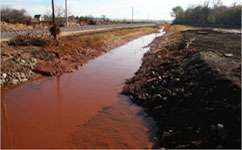Hungarian red mud spill did little long-term damage

The aftereffects of the 2010 red mud spill that threatened to poison great swathes of the Hungarian countryside have turned out to be far less harmful than scientists originally feared.
The disaster happened when weeks of heavy rain caused a dam to collapse at a containment facility in Ajka in Western Hungary. It released around a million cubic metres of toxic sludge into the Torna-Marcal river system, onto the Hungarian plain and ultimately into the Danube.
The mud, a byproduct of refining aluminium from bauxite ore, was dangerously alkaline, extremely salty and contained potentially toxic metals like chromium and vanadium.
And this was the first time red mud had ever been released into the environment in such large quantities. We didn't know exactly what the effects would be, but some commentators feared the long-term effects on people and wildlife could be severe.
But a new study in Environmental Science: Processes & Impacts shows that there's hardly any trace left of the red mud in the Tornar and Marcal rivers downstream of the spill.
'It's a good news story,' says Dr Will Mayes of the University of Hull, the paper's senior author. 'Our results show that the combined effect of the structure of the sediment and the Hungarian government's remediation efforts have mostly dealt with the spill's aftereffects – we found the geochemical signal from the red mud has almost completely disappeared.'
Things turned out so well partly because the Hungarian government acted quickly, spending around €127 million on dredging mud out of rivers and removing it from the flood plain, as well as dosing it with acid near the source of the spill and then adding gypsum further away in an effort to reduce its dangerous levels of alkalinity.
The fine-grained nature of the red mud also meant that in many areas any sludge that didn't get cleaned up was quickly washed downstream and into the Danube river, which is so huge that it was soon diluted to the point of harmlessness and flowed out to sea.
'There was a lot of red mud, but in the context of the Danube river system's size and rate of flow it doesn't seem to have had much impact,' Mayes explains.
He received urgency funding from NERC in the immediate aftermath of the spill; his team travelled to Hungary and worked with Hungarian geoscientists to test sediments in the rivers downstream. At the time they found numerous alarming pollution hotspots where toxins from the mud seemed to be building up, although it also turned out that many of its most concerning components were present in forms that aren't particularly easy for living things to absorb. Others, though, such as vanadium – a metal suspected of causing cancer – were there in highly concentrated and bioavailable form.
For this latest study they returned and rejoined their Hungarian colleagues to re-test the river sediments at the same places. And even at the worst former pollution hotspots, there was little trace of the red mud.
Mayes says the knowledge gained in the wake of the Ajka spill will help governments deal better with similar events in future.
'This kind of catastrophic environmental event means we gather a lot of information in a short time,' he says. 'There hadn't been any large-scale spill of this material before, so we didn't really know how it would affect the environment; what we have found out over the last few years means we're in a far better position to manage these risks in future. It's just a shame it takes a huge disaster to move things on and make us gain this knowledge.'
Thankfully, the situation in Hungary is not representative of the alumina industry as a whole and the refinery in Hungary is now using more modern technologies that produce drier by-products that reduce the risk of spills. Mayes even has another NERC-funded project looking at recovering valuable metals from aluminium refining waste, such as chromium, vanadium and rare earths; if we could find a way to recover these economically, this would both create a potentially valuable income stream and reduce the waste's potential environmental impact.
Other NERC-funded researchers including Professor Paul Younger, then of Newcastle University, and scientists from the British Geological Survey also travelled to Hungary after the spill, offering expert advice on the government's response to the disaster. These included suggestions on how to build an effective retaining wall at the site of the disaster that would prevent any further mud spillage, using modern methods that took account of underground conditions and the way water moves through the earth.
More information: "Geochemical recovery of the Torna-Marcal river system after the Ajka red mud spill, Hungary." Á. D. Anton, O. Klebercz, Á. Magyara, I. T. Burkec, A. P. Jarvisd, K. Gruiz and W. M. Mayes. Environmental Science: Processes and Impacts (2014), DOI: 10.1039/C4EM00452C.
Provided by PlanetEarth Online
This story is republished courtesy of Planet Earth online, a free, companion website to the award-winning magazine Planet Earth published and funded by the Natural Environment Research Council (NERC).



















